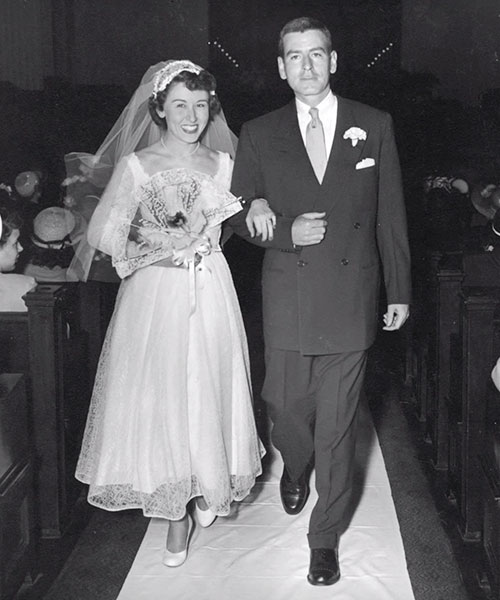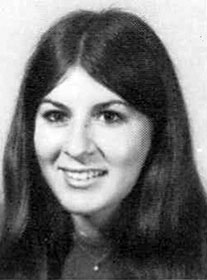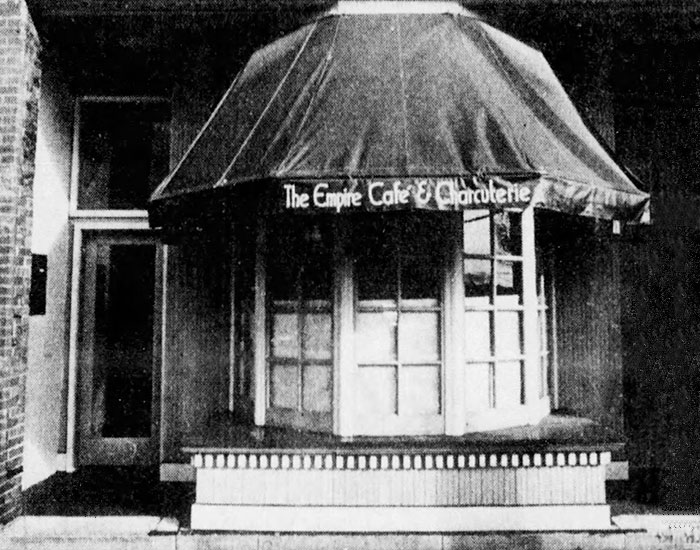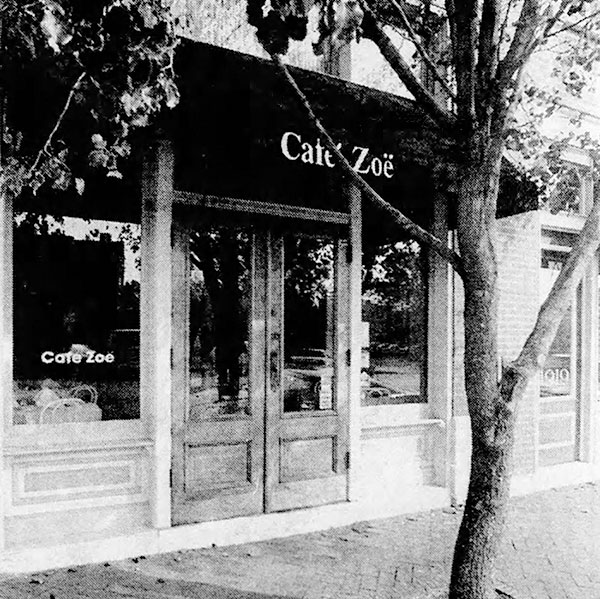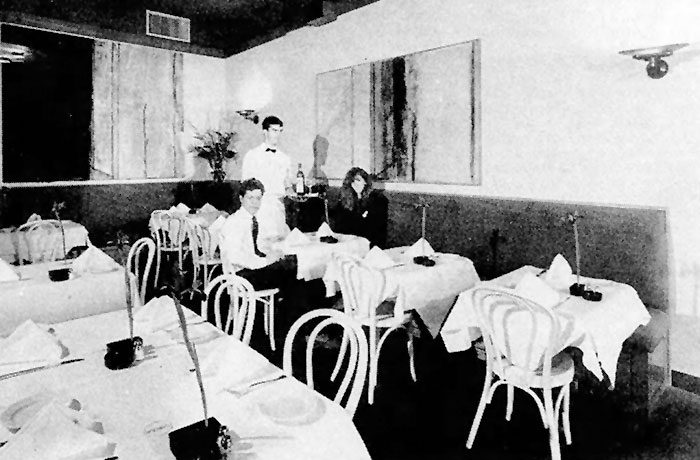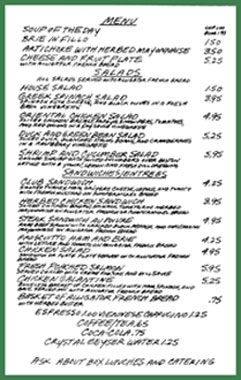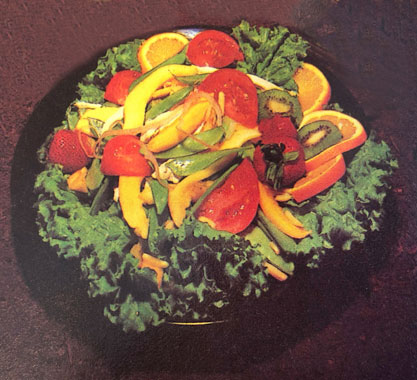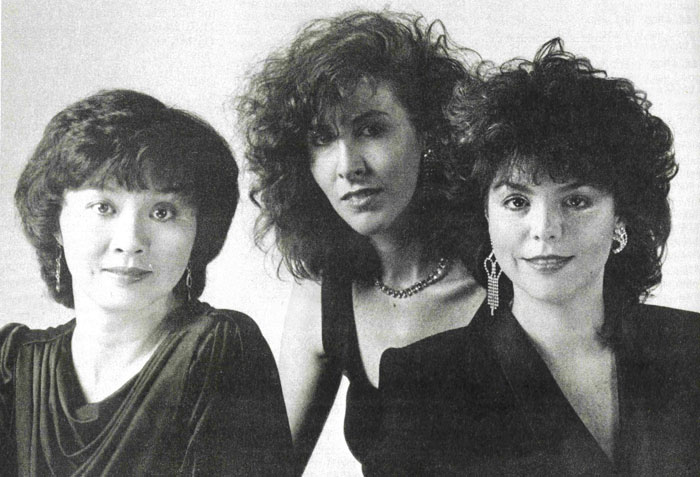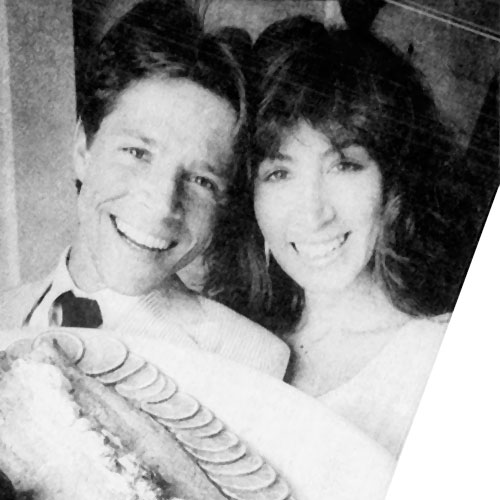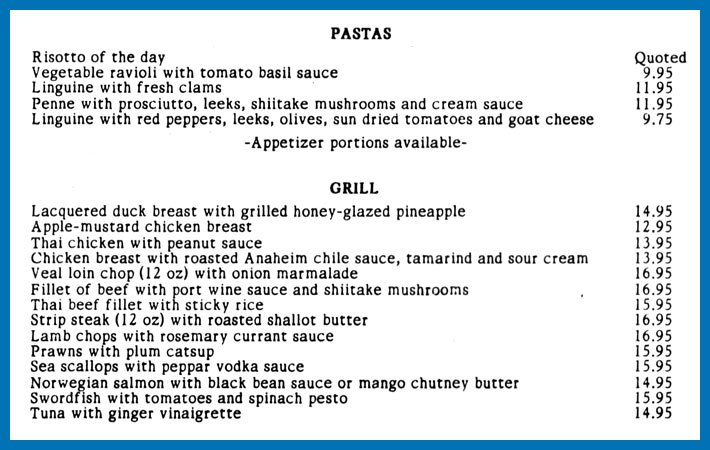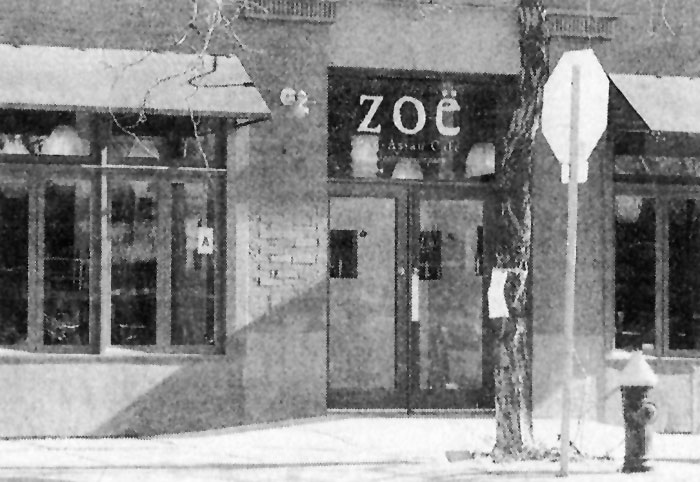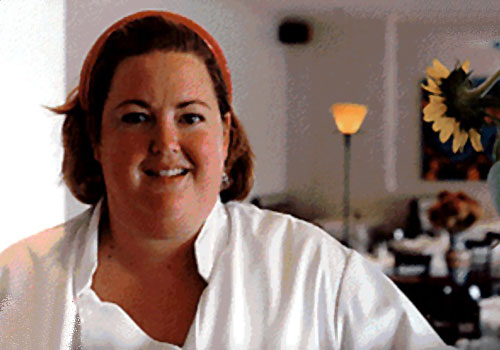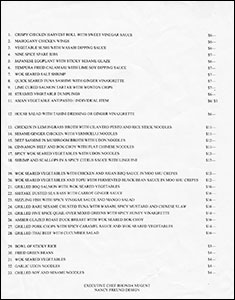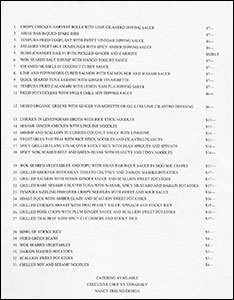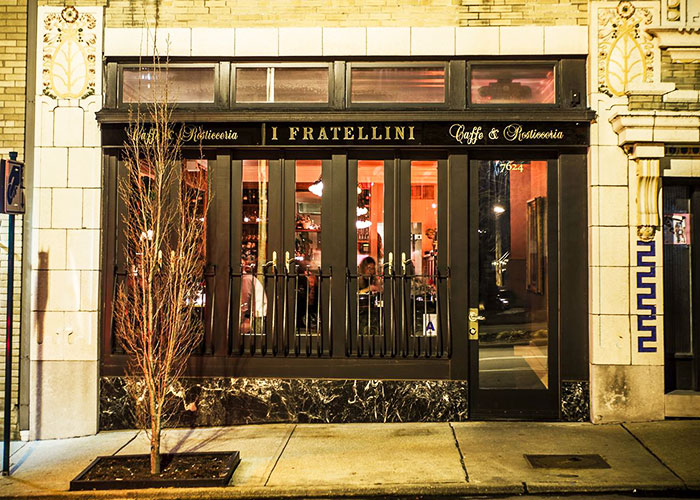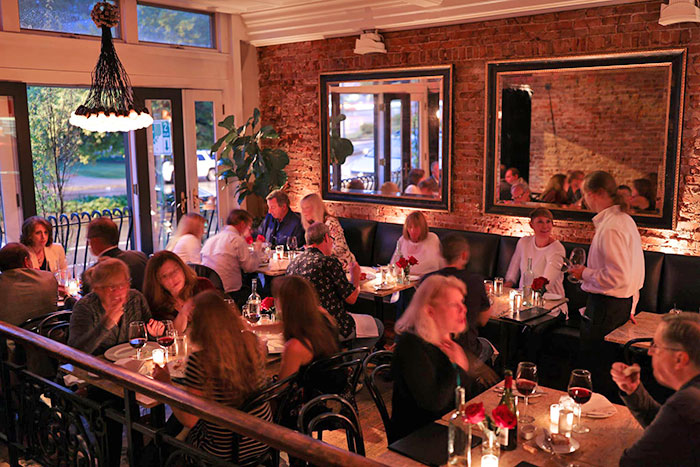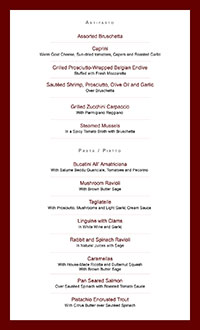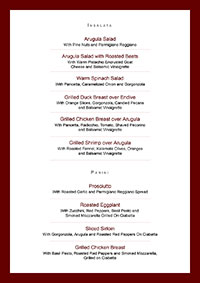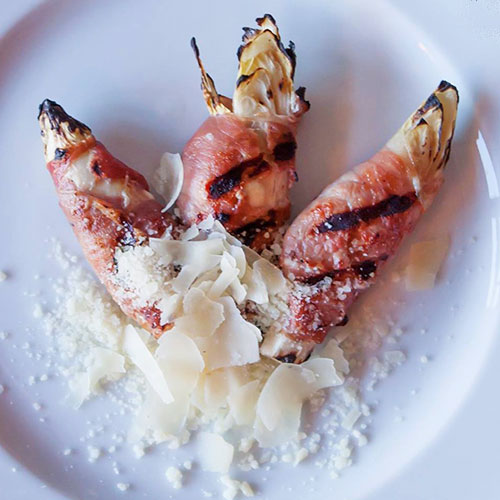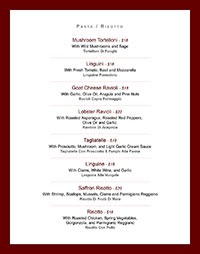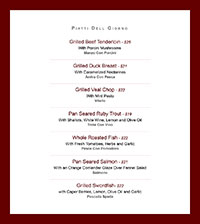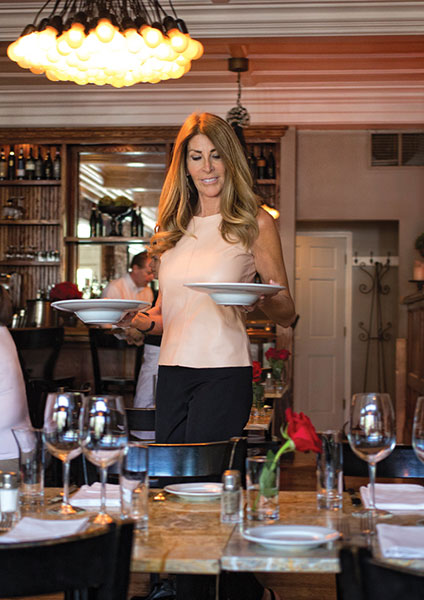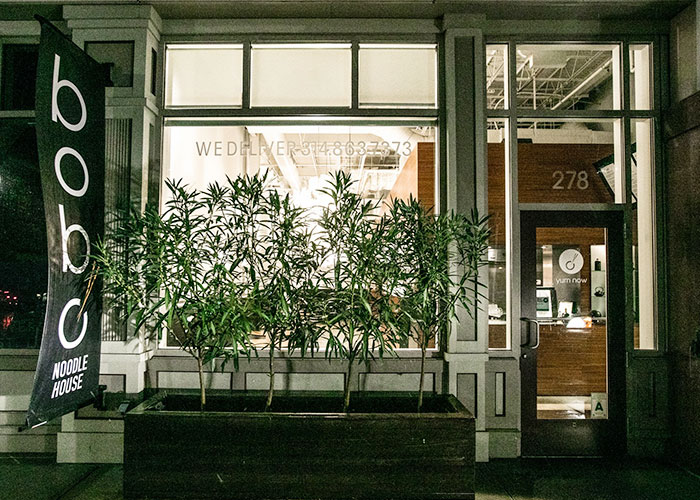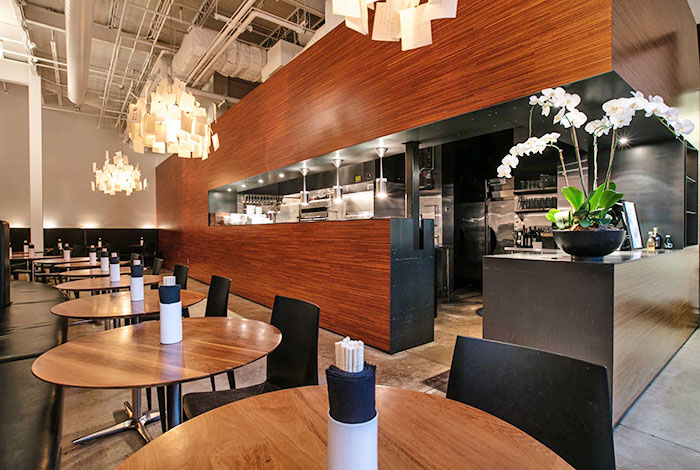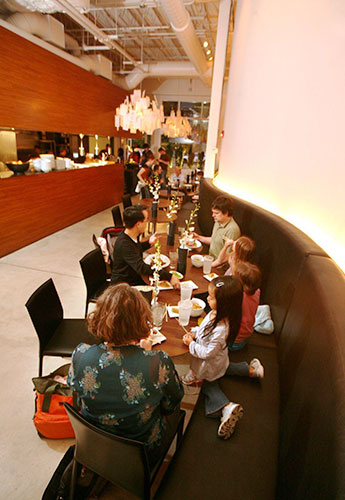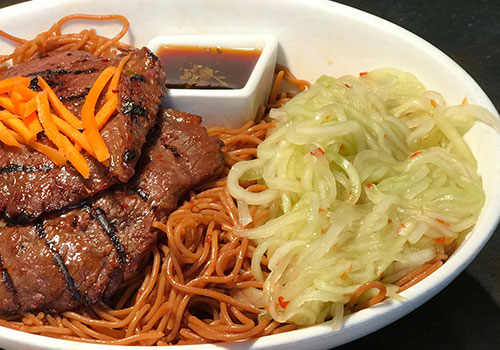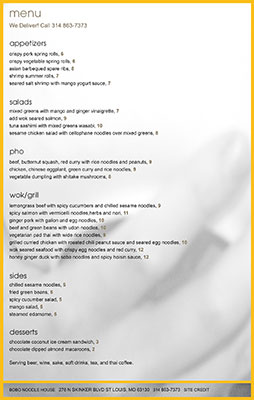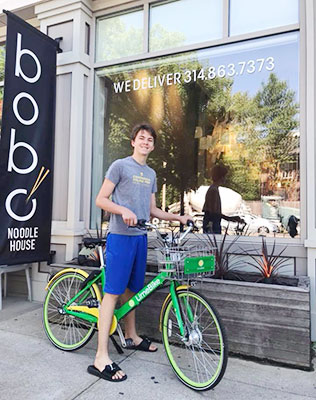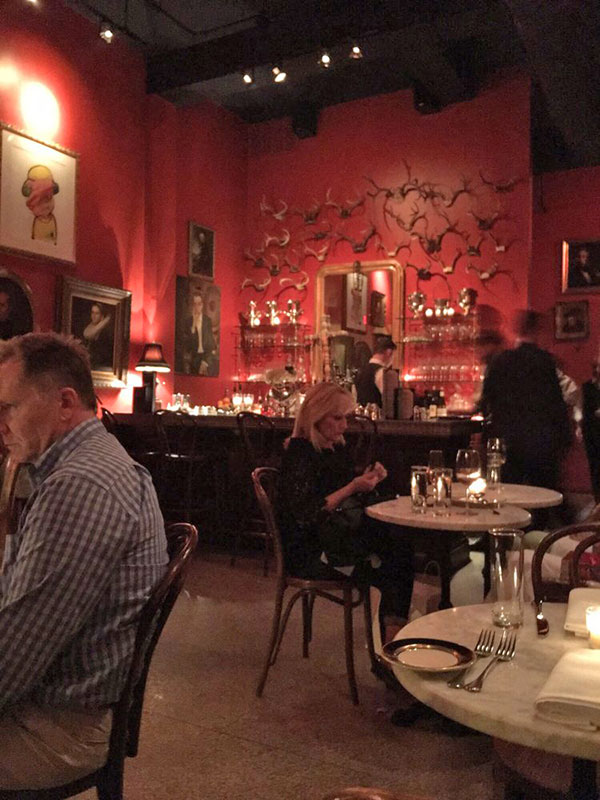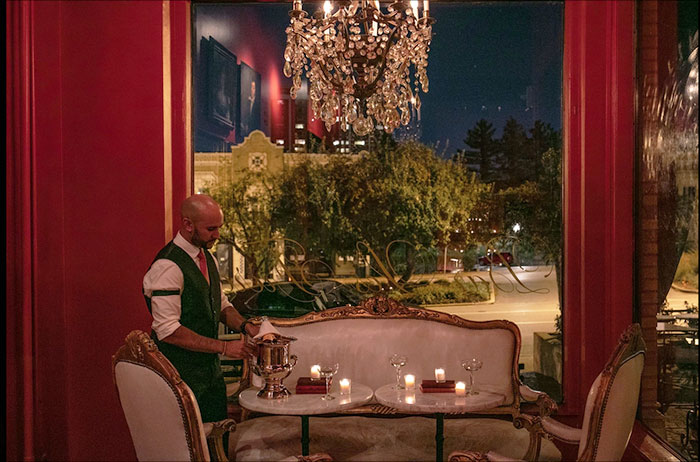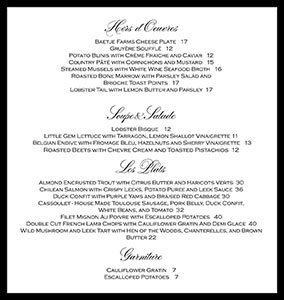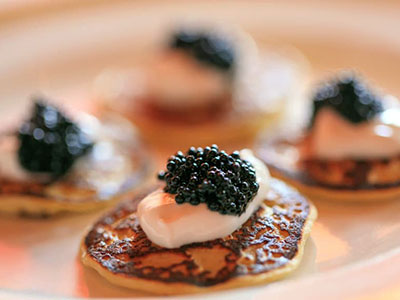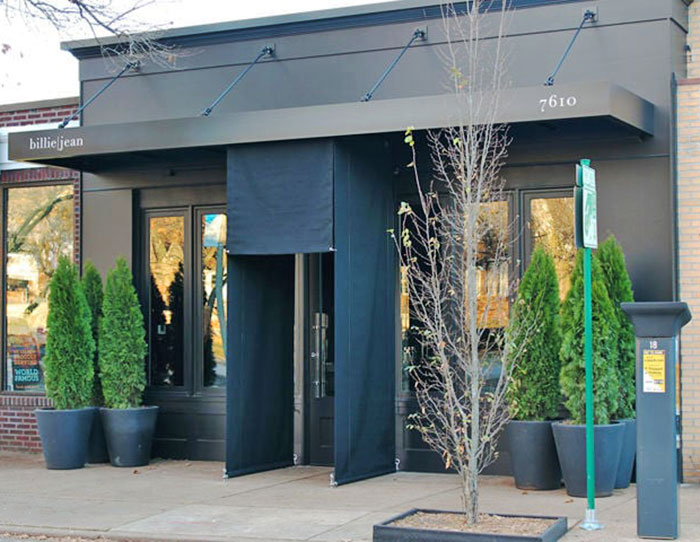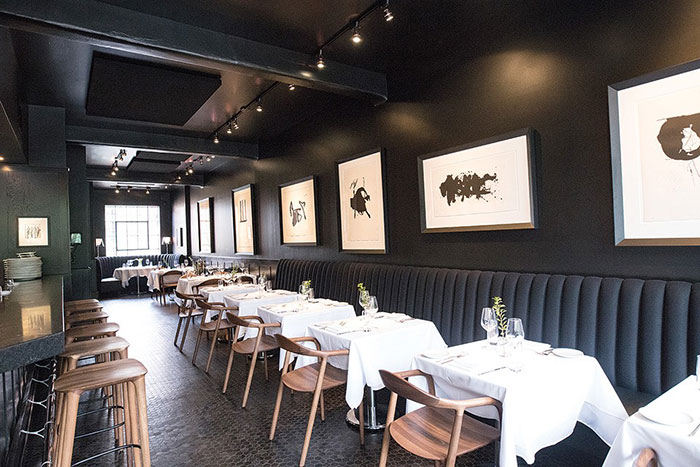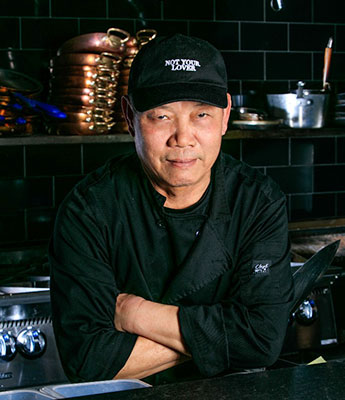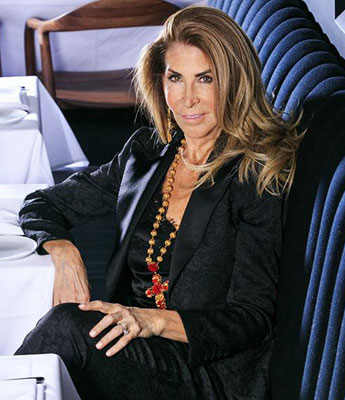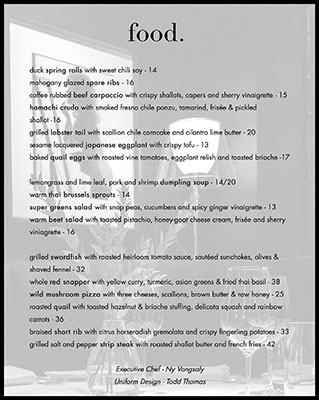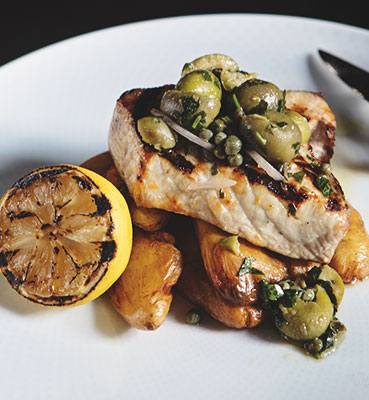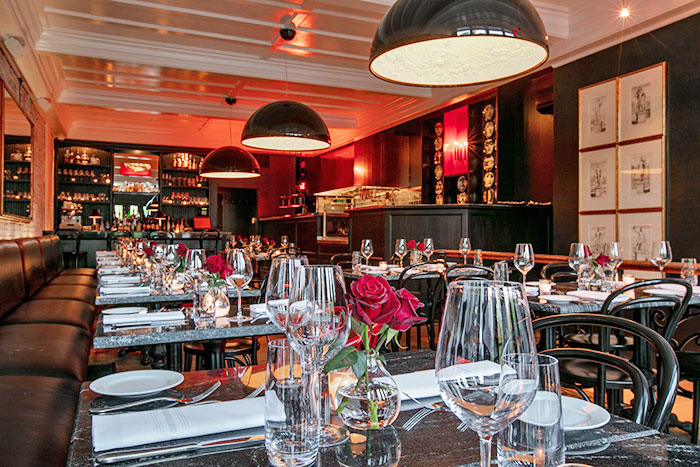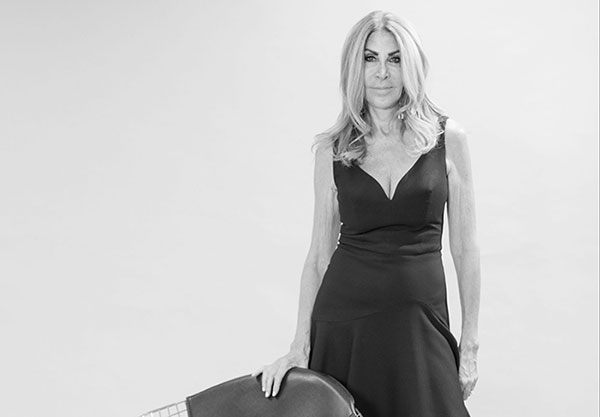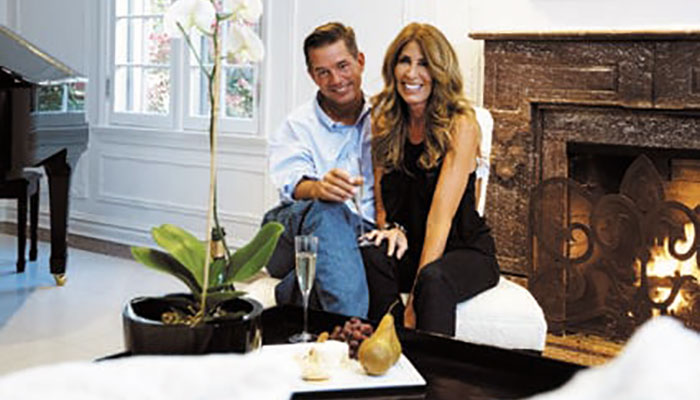|
Zoe
Zoe Elizabeth Houk was born in St. Louis in
1958. She grew up in Crestwood with her parents and her two older
sisters, Belinda and Carrie. Her parents ― Jean and Billie Houk ―
both worked for Union Electric; her father was an executive and her
mother was an accountant.
Zoe's father died of cancer on August 30, 1964 at the age of 43.
After graduating from Lindbergh High School, Zoe attended classes at Meramec and Forest Park community colleges.
Zoe's first job as a waitress was at The Loft on Mason Road.
The Ladle followed, and at each restaurant Zoe
learned a little more about the business. In 1981, she moved on again
― to the Empire Cafe in Lafayette Square.
In May of 1980, Jill Mead and Susan Vaughn opened The Empire Cafe and Charcuterie at 1923 Park Avenue. The Empire menu included soups, salads and sandwiches. The most popular item was the chicken salad, described by Joe Pollack in his March 12, 1981 St. Louis Post-Dispatch review.
Zoe Houk had waited tables at the Empire Cafe for about a year when she was pegged to manage Empire's new venture, the Shell Empire Cafe, which opened in August of 1982 in the renovated Shell Building at 13th and Locust. However, all was not well at the Empire, as Mead and Vaughn clashed over how to run the business. The turmoil led to the closure of the Lafayette Square restaurant in December of 1982, shocking the Empire's enthusiastic customer base. Zoe, who was still managing Empire's restaurant in the Shell building, was at the right place at the right time.
In February of 1983, Zoe took over the Lafayette Square space with her partner, Steve Robinson, who she had met a few years earlier when the two were working at Caleco's.
Cafe Zoe opened its doors four months later, on June 1, 1983.
While it was the place that Jill Mead and Susan Vaughn had built, Cafe Zoe took on an identity of its own.
Seating was available in two large rooms. The
space became more sleek and less
cute, losing its bay window. Light from the storefront's large
windows shone on the interior's muted grays, charcoals and
off-whites. Local artists were invited to hang their works on the
restaurant's stark white walls.
All was not perfect at the start. Within a week after opening, Zoe fired both her chef and her restaurant consultant.
Zoe hired new cooks and redesigned the menu. One of those cooks was Laotian born Ny Vongsaly, who had worked with her at the Empire Cafe. Though never professionally trained as a chef, Vongsaly learned about food by watching his mother and sisters. He picked up their techniques and traditional Laotian recipes well enough to impress Zoe and his other co-workers at the Empire. After a few months at Cafe Zoe, Vongsaly became the restaurant's executive chef, creating a menu of dishes influenced by the food he'd grown up eating in Laos, as well as what he concocted while experimenting at home.
Vongsaly would eventually leave Cafe Zoe for
Modesto, California to reconnect with his brother and sister. But he would reconnected with Zoe in 1998 in an enduring partnership that would take him to James
Beard semifinalist status.
Zoe expanded the Empire menu and the dishes became more bountiful. She adding her longtime dream, Oriental Chicken Salad. Most of the changes were directed at attracting a new clientele — men in general, and business people in particular. As the Empire Cafe, the restaurant had a reputation as the kingdom of chicken salad and the mecca of the ladies who lunch. Zoe began attracting a broader clientele. Lunch was served Monday through Saturday. The lunch menu included soup of the day, two or three appetizers, five salads and seven entrees, some of which were sandwiches. The chicken salad, which built the Empire Cafe's reputation, remained on the menu. Whether ordered as a sandwich with homemade white bread or alone atop lettuce, it set the standard for chicken salad in the city. Dinner was served on Friday and Saturday nights only. Entrees included broiled chicken sprinkled with rosemary and lemon juice, baked Cornish hen with apricot brandy sauce, chilled broiled beef tenderloin with mustard sauce, sautéed shrimp in pesto sauce, and broiled salmon filet with citrus butter. Salads, sandwiches and appetizers were carried over from the lunch menu.
Special dishes
came and went and then came back again, if they were favorites. One
that appeared periodically was asparagus wrapped in prosciutto,
served with vinaigrette.
Cafe Zoe was a success from day one. Crowds flocked to the little restaurant to enjoy the fresh, simply prepared food. Zoe's restaurant was one of the top places in town "to be seen." Food critics loved her food and the media loved Zoe.
Zoe Houk and Steve Robinson were married on
October 17, 1987 in Taos, New Mexico after an eight-year courtship.
The wedding took place before a justice of the peace and two
9-year-old girls who were summoned from a nearby playground by the
couple to serve as witnesses.
In a June 12, 1990 St. Louis Post-Dispatch article, Jerry Berger reported that the Robinsons had sold their Lafayette Square restaurant to Richard Cole who would rename it Park Avenue Cafe. Berger went on to report that the Robinsons were moving Cafe Zoe to Clayton. Cafe Zoe opened at 12 North Meramec in November of 1990. According to Zoe, the location in the midst of the hustle and bustle of the city was where she had always pictured herself.
The new restaurant was more spacious. It was
bathed in cool grays and whites, with French blue art
deco lamps. Colorful contemporary paintings hung on the walls over
black and white striped booths. Gray carpeting imprinted with
pale gray leaves covered the floor. Wide windows overlooking Meramec added to the light, airy atmosphere. One constant was a
cheerful greeting from Zoe, who was almost always on hand.
Along with lunch, dinner was now served six days a week. There were more Italian touches to the menu, with a selection of pizzas and pastas. Pizzas were topped with salmon, capers, dill and mascarpone; plum tomatoes, basil, mozzarella and pine nuts; eggplant, sun-dried tomatoes, basil and fontinella; or shrimp, pesto, fennel, black olives and ricotta.
There was also a risotto, which changed daily.
The
risotto with spinach, pine nuts, sun-dried tomatoes and fontinella was a
favorite.
In October of 1997, it was announced that Zoe was again on the move. She and Steve Robinson had parted ways and sold their restaurant at 12 North Meramec to Mike Johnson, who would open Cafe Mira in the space.
But Zoe did not divorce herself from the restaurant business.
On January 28, 1998, Zoe Pan-Asian Cafe opened on
the corner of McPherson and Euclid in the Central West End.
The idea for Pan-Asian cuisine was inspired by the Thai and Laotian employees who had worked for Zoe in Lafayette Square. Rhonda Nugent, who had been the executive chef at Cafe Zoe, moved into the same position at Zoe's new restaurant.
But, Zoe wasn't content with "two white girls"
in her Pan-Asian kitchen. Ny Vongsaly, who had returned from
California, was working with Patty Long Catering. By the end of the
year, Zoe had lured him back as her executive chef.
Zoe Pan-Asian had a sleek Asian decor. Black wood tables and chairs contrasted with white walls and light wood floors. Pillows in shades of curry, lime and purple lined the black window seats, and white paper Japanese lanterns hung from the ceiling. Candles in tall glasses wrapped in Asian joss paper illuminated the tables, as well as the wall behind the long bar. Zoe's Asian-accented food was flavored with fresh mint, basil and cilantro, as well as dried cardamom, cloves, cumin and Sichuan pepper.
The highlight of
the appetizers was the tempura-fried calamari with lime-soy dipping
sauce. Among the entrees,
grilled
Thai beef with spicy cucumbers and
sticky rice was a standout. A favorite dessert was roasted bananas
with a bit of coconut-crème anglaise. After Zoe Pan-Asian had been opened for about two years, Zoe decided to return to Clayton.
Zoe and her Pan-Asian chef, Ny Vongsaly, spent two weeks cooking in a chef's kitchen just outside of Florence. Their goal was to return to St. Louis and open a rosticceria ― an informal Italian cafe and market. Zoe found a storefront space on Wydown which had housed Davis Electronics for many years, and then a children's theater.
Zoe opened her rosticceria at 7624 Wydown
Boulevard in Clayton on November 28, 2001. She called it I
Fratellini, Italian for "the little brothers," named for her young
sons, Spencer and Eli.
The intimate space accommodated a dozen marble-top tables for 40 diners. Maroon-and-gold striped banquettes backed up to an exposed brick wall, lined with large mirrors. The mirrors, along with French doors facing the street, gave the place an airy feel. Overhead fixtures resembled bouquets of light bulbs suspended from black wires. Tables were adorned with red roses and clear wine bottles, which served as water pitchers.
A small bar with five stools was at the far end
of the restaurant. A glass display case just beyond a tiny waiting
area showed off desserts and Italian specialty products, available for carryout.
Ny Vongsaly divided his time between Clayton and the Central West End. Though he'd never really cooked Italian food, his culinary trip to Italy made him realize how much it had in common with Laotian cuisine.
I Fratellini served both lunch and dinner. The
lunch menu started out relatively simple,
with four choices each of antipasto, salad, pasta and panini. The
sirloin and gorgonzola panini was a signature dish.
Grilled prosciutto-wrapped Belgian endive was a
popular starter at dinner. There was a large list of pastas, most of them
homemade. Roasted trout topped with slices of prosciutto and sage
was a favorite entree.
Zoe was hands-on at I Fratellini ― as she was at all of her restaurants.
In October of 2007, it was announced that Zoe was selling her Pan-Asian restaurant in the Central West End to Scott Clark, who had worked as a chef at Cafe Zoe in Clayton. He reopened it under the name Sapphire Pan-Asian. But by October of 2008, Zoe had opened another restaurant ― Bobo Noodle House.
Bobo Noodle House was on Skinker Boulevard, across from the Washington University campus. Its narrow storefront space was anchored by a laminated "wood box" which housed the kitchen and order counter. A curving black banquette offered seating for about 30 diners on the opposite wall. Light fixtures featured dozens of fluttering pieces of paper with fortune cookie-style messages.
Counter service was the methodology for both
dine-in and takeout dining. A robust delivery service was also
provided, with most of the recipients Washington University
students.
Chef Ny Vongsaly blended noodle traditions from
all over Asia. Some of his menu items were carryovers from Cafe Zoe
and Zoe Pan-Asian, including the
Asian barbecued spare ribs, a signature appetizer. The vegetable
dumpling pho was a popular dish, particularly on a cold winter day.
Heading the list of entrees was lemongrass beef with spicy cucumbers
and chilled sesame noodles.
Grilled curried chicken with roasted peanut sauce and seared egg
noodles was also a favorite.
In the summer of 2011, the Wydown Shoe Service ― across the street from Zoe's I Fratellini ― closed its doors.
Zoe leased the space and transformed the small shoe repair into a French bistro. She debuted Bar Les Frères in November of 2012.
Zoe had intended Bar Les Frères to be a waiting area for her guests at I Fratellini.
But Bar Les Frères did indeed become a serious restaurant. After it had been open for just over a year, Zoe expanded the space by incorporating the vacant storefront next door, nearly doubling the capacity.
Bar Les Frères had the appearance of an elegant Paris bistro. Its red walls were adorned with gold-framed antique portraits. Its tables were white marble and illuminated by tea lights. Its seats were comfortable settees and elegant armchairs.
An inviting bar provided the focal point of the
restaurant, with soft lighting, an antique mirror and an array of
antlers. A large picture window showcased the tree-lined street
outside.
Ny Vongsaly handled
executive-chef duties at Bar Les Frères, in addition to I Fratellini
and BoBo Noodle House. His French bistro fare included soufflés,
blinis, patés, confits and cassoulets. In December of 2015, Zoe announced she had sold Bobo Noodle House to Kary Lockwood, a longtime friend and former employee. She also announced she was working on a new restaurant project in the same neighborhood as I Fratellini and Bar Les Frères.
The space, a few doors east of I Fratellini, had been a frozen yogurt store. But the transformed space would not be serving yogurt ― or Italian or French.
Zoe named her new restaurant in honor of her
mother and father. Billie-Jean opened on December 21, 2017.
Zoe's new restaurant was draped in a monochromatic veneer, from the matte black entryway to the black-on-black interior motif. The shotgun-style space featured a black ceiling, ebony paneling and black banquettes, with black-and-white Robert Motherwell prints on the wall. Carved walnut chairs and curved walnut bar stools provided contrast.
Billie-Jean had the feel of a mid-century
Manhattan supper club, complete with matchboxes, dice and poker
chips on the bar.
A black-and-white photograph of Zoe's parents was presented on a
postcard with every check, a touch that added to the old-fashioned
vibe.
Billie-Jean's menu was a combination of executive chef Ny Vongsaly's Asian influences and Zoe's favorite Mediterranean flavors.
The compact menu balanced smaller plates and full-sized entrees. Starters included coffee-rubbed beef carpaccio, spicy yellowfin tuna lettuce wraps and baked quail eggs. Mahogany glazed spare ribs were a holdover from the menus at both the original Cafe Zoe in Lafayette Square and Zoe Pan-Asian Cafe.
Heartier courses
included grilled swordfish with Castelvetrano olives, whole roasted
snapper and honey and soy-glazed roasted quail. More traditional
offerings included a grilled strip steak and a three-mushroom pizza. In October of 2018, Zoe closed I Fratellini for a week to "refresh" its interior.
The changes included an
introduction of Louboutin red in specific areas around the
restaurant. The brick walls were whitewashed and a high-gloss finish
on the ceiling was used for contrast. The woodwork was stained a
shade darker and new light fixtures were added.
With Billie-Jean, Zoe had three critically-acclaimed restaurants on Wydown. It elevated the neighborhood into a culinary destination and Zoe’s personal "restaurant row."
By the end of the decade, Zoe Robinson was on top of the world.
And then Zoe's world turned upside down.
As COVID-19 spread through the population at the beginning of 2020, Zoe struggled with the pandemic, as did all restaurant owners. On March 13, she verbalized her angst on Facebook.
On March 16, just three days later, she changed course.
And on March 20, Zoe changed course again.
In early June of 2020, as restaurants were starting to reopen with limited capacity, Zoe's restaurants remained closed.
On May 3, 2021, it was announced that St. Louis restaurants could increase to 100 percent of allowable capacity, both indoors and outdoors. Zoe's restaurants had been closed for more than a year.
By November of 2021, Zoe was living in Aspen, Colorado. On November 10, she announced the sale of her three Clayton restaurants to Susan Barret, a local art collector and gallerist, who had worked at Cafe Zoe in the 1980s. Zoe also disclosed she had been diagnosed with breast cancer the prior November.
The sale of Zoe's restaurants to Susan Barret never materialized. In April of 2022, it was announced that Zoe had sold Bar Les Frères to restaurateurs Michael and Tara Gallina, who would open their own French restaurant, Bistro La Floraison, in the space. The following month, Zoe announced she had sold I Fratellini to Matt McGuire, who would reopen it as a steak house called Wright’s Tavern.
And in August, it was disclosed that the
Billie-Jean space had been sold to Ben Poremba, who would reopen it
as Bar Moro, featuring Mediterranean cuisine.
As 2022 wound down, Zoe reflected on the closure and sale of her restaurants.
Copyright © 2022
LostTables.com |
||||||||||||||||||||||||||||||||||||||||||||||||||||||||||||||||||||||||||||


